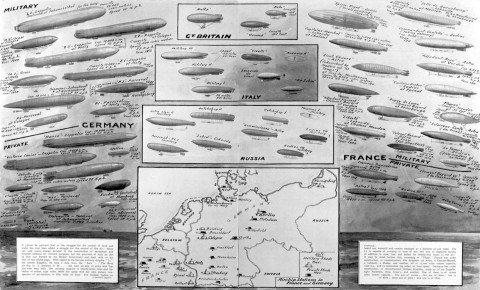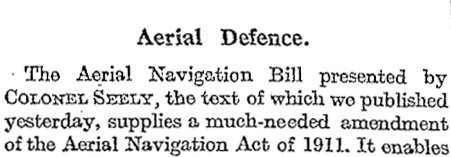TO ILLUSTRATE THE SO-CALLED ‘BLACK SHADOW OF THE AIR-SHIP’, A MAP OF JOURNEYS POSSIBLE TO AEROPLANES AND DIRIGIBLES.
This week’s issue of the Illustrated London News devotes three whole pages — mostly taken up with illustrations, of course — to an examination of what a headline calls ‘A MENACE THEORY’: ‘IS IT “THE SEA TO US, THE AIR TO THE FOE”?’ (p. 239). Some of the material, including the maps above and below, is taken from an article in the latest issue (dated 3 February) of the Review of Reviews which has attracted considerable attention, not least because it is so visually striking. As the ILN explains:
The Government’s new Act, designed to prevent the unauthorised flying of air-ships over the United Kingdom, lends special interest to the illustrations on this page, especially to the two maps [which illustrate] admirably a belief that is common to a good many people in this country, who see grave menace in the air and are not a little eager, therefore, that Great Britain’s air-craft shall not only be increased in numbers and strength, but be increased without delay; on the principle that if a people is to have pace it must be prepared for war.
The ILN explains that ‘The reported flights made over England by unknown air-ships have led the Government to construct a Bill dealing with the matter’ (p. 240). Noting Colonel Seely’s claim that the new legislation was directed against airships belonging to private pilots, not foreign powers, the ILN comments (p. 241):
This, of course, is putting the case somewhat mildly; for there can be no doubt that the law will be so designed that it will be perilous also for unauthorised air-craft to pass over fortifications, harbours, and naval bases.
And, of course, aircraft are now important weapons of war (p. 240):
It cannot be gainsaid that to the struggle for the control of land and water has now been added a struggle for the control of the air; hence not only much energy devoted to the construction of aeroplanes and dirigible balloons, but the provision of such as Act as that framed by the British Government […]
The Act (as it now is) permits ‘proper officers […] to fire at, or into, any such aircraft, and use any and every other means’ to stop it from flying over prohibited areas (p. 240). The ‘signal of warning to quit’ will probably be ‘a column of smoke’ by day, or ‘flares, rockets, or some such device’ by night (p. 241).
Regarding the map shown above, the ILN says that the Review‘s editor ‘notes’ (apparently in private correspondence) (p. 239):
The first circle of 125 miles from Heligoland gives the out-and-home journey of an aeroplane; the 250-mile circle is the outward journey only. The 300-mile circle is the out-and-home journey of an air-ship; the 600-mile circle is the outermost line; that is, practically the limit of an air-ship journey without any hope of return.
So the map, then, is quite misleading: only a sliver of Norfolk lies within the 300-mile circle. Most of the country, including London, is actually free from the ‘black shadow of the air-ship’ unless the Germans were inclined to send their expensive new Zeppelins on one-way missions! In an attempt to gloss over this, an additional note from the same source says:
if an air-ship started from Borkum, or from the Belgian frontier, instead of from Heligoland, it would be much nearer London than if Heligoland were its headquarters; and doubtless could get to that city and back.
Just.
TO ILLUSTRATE THE ARGUMENT THAT THE BRITISH ISLES ARE AT THE MERCY OF GERMAN AIR-SHIPS: A MAP OF DISTANCES.
The other map from the Review zooms in on the British Isles in a very attractive perspectival style, with the Shetlands peeking above the horizon at the top, and a fleet of Zeppelins hovering menacingly above. It shows the range from Heligoland (or sometimes Cologne) to various important potential British targets: 300 miles to London, for example; 340 miles to Aldershot; 530 miles to Scapa Flow. Again, though, most of these represent one-way trips.

THE DAMAGE A DIRIGIBLE CAN DO: THE OASIS OF GHARIUNES FIRED BY A BOMB DROPPED BY MILITARY AIR-MEN.
No explanation of this photograph is given, apart from the caption. It was presumably taken from an Italian aircraft over Libya during a bombing mission in the recent Italo-Turkish War. In any case, it’s a bit difficult to make out what’s going on; presumably that’s a cloud of dust or smoke from a bomb near the centre of the photograph.

THE KIND OF TARGET A MILITARY DIRIGIBLE WOULD HAVE: A SECTION OF A GERMAN TOWN AS SEEN FROM ABOVE.
This one, though actually completely pacific, is rather more striking. From this vantage point, those sturdy buildings look like toys and the people like ants. It seems like they could be crushed very easily.
The next illustration takes up a full two-page spread and is drawn by the ILN‘s own W. B. Robinson (though with acknowledgement to Review of Reviews and Flight). It shows the relative sizes of the airship fleets of Germany, France, Russia, Italy and (last and least) Britain, along with each airship’s name, and, where available, location, size, speed, and so on. There is also a map of airship stations in Germany and France. (Heligoland is not listed as having an airship base, which might seen odd given the ‘black shadow of the air-ship’ map is centred on it; this is probably because the airship hangars on Heligoland have been planned, and announced, but not yet built.) The title reads (pp. 240-1):
WHY LAWS ARE MADE TO PREVENT UNAUTHORISED FLYING OF AIR-SHIPS OVER FOREIGN TERRITORY.
THE STRUGGLE FOR THE CONTROL OF THE AIR: MILITARY AND NAVAL DIRIGIBLES OF THE POWERS: AND PRIVATE DIRIGIBLES WHICH MIGHT BE COMMANDEERED IN TIME OF WAR — SHOWING GERMANY AND FRANCE IN THE VAN.
Not only does Germany possess the most airships, it has the best airships too (pp. 240-1):
With regard to the German military dirigible ‘L1,’ the newest Zeppelin, we take a note from the ‘Aero’: ‘The Navy air-ship L1 is declared to be… the best air-ship in every way that has ever been built. Her carrying capacity is twenty-seven tons and her radius of action 1530 miles, while her speed with her own motors, irrespective of air-currents, is fifty miles an hour. The wireless station on board can transmit and receive messages at a distance of 310 miles. The L1 is capable of carrying in time of war two tons of explosive bombs, in addition to crew, fuel, and ballast for twenty-four hours in the air.’
And both Germany and France are increasing their superiority still further:
It may be noted further that, according to ‘Flight’, France has under construction, or reconstruction, five dirigibles — an Astra, a Clement-Bayard, a Lebaudy, a Zodiac, and another, all of 17,000 cubic metres capacity, 1000 h.p., and 70 kilometres (44 Miles) an hour speed. Germany has under construction, or reconstruction, thirteen dirigibles, made up of one Zeppelin, eight Parsevals, three Gross’s, and another. One of these is of 19,000 cubic metres capacity; five are of 10,000; two are of 8000; one is of 6700; three are of 5200; and one is of 1800.
The reader would be entitled to feel somewhat alarmed after all that.
There is one other mention of phantom airships in the papers today. The Bath Chronicle gives what amounts to free publicity to a talk in Bath being given next week by Samuel Franklin Cody on ‘The National Aspect of Aviation’ (p. 6). It consists of a long recitation of his various aeronautical accomplishments, including winning ‘the first prize both in the British and in the International divisions of the British War Office Aeroplane Competition‘. Indeed,
Probably there is not a finer pilot in the world, or one who has a more thorough and business-like knowledge of the moods and manners of the air which, thanks in no small measure to Col. Cody, man has at last conquered.
The uncomfortable fact of his American origins can now be put aside, since
S. F. Cody is now an Englishman, having sworn fealty to the King; and since his Majesty, in a recent message of congratulation, addressed him as ‘Colonel Cody,’ that title, which he had never claimed but which had somehow become associated with his name, must remain. Colonel Cody he is. But his name must not be confused with that other Cody who was known as ‘Buffalo Bill.’
The Chronicle predicts that Cody’s talk will have a large audience, ‘especially when so much interest, not to say dismay, has been created in the country by the mysterious flights of foreign airships over our land’.
![]() This work is licensed under a Creative Commons Attribution-NonCommercial-NoDerivatives 4.0 International License.
Permissions beyond the scope of this license may be available at http://airminded.org/copyright/.
This work is licensed under a Creative Commons Attribution-NonCommercial-NoDerivatives 4.0 International License.
Permissions beyond the scope of this license may be available at http://airminded.org/copyright/.









Pingback: Saturday, 1 March 1913
Pingback: Secret Zeppelin bases in Britain — I | Airminded
Pingback: Secret Zeppelin bases in Britain — II | Airminded